An ensign is another term for a flag. Originally, an ensign was a flag flown at the stern of a ship to denote nationality. The term ensign is now associated with flags flown by government services on land as well.
The ensigns of the Australian Defence Force
The Australian Army has no separate ensign but has the ceremonial role of protector of the Australian National Flag. The Australian Defence Force ensign represents the Australian Defence Force as a whole. The Royal Australian Navy and the Royal Australian Air Force have their own distinctive ensigns, which have evolved from the flags of their counterpart British services.
Use of Defence ensigns
The Department of Defence issues instructions on the proper use of the defence ensigns.
The Australian Defence Force ensign
The Australian Defence Force ensign represents the three services of the Australian Defence Force: the red stripe represents the Australian Army, the dark blue stripe represents the Royal Australian Navy and the light blue stripe represents the Royal Australian Air Force. The defence force emblem in the centre of the flag also represents the three services: the crossed swords represent the army, the anchor represents the navy and the eagle represents the air force. The Commonwealth Star and the boomerang represent Australia.
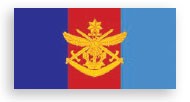
THE AUSTRALIAN DEFENCE FORCE ENSIGN
The Royal Australian Navy ensign
The Royal Australian Navy adopted the Australian white ensign in 1967. The white ensign of the British Royal Navy had been used since 1911, when the Royal Australian Navy was formed. The Australian white ensign is usually flown from the stern of a navy vessel, while the Australian National Flag is flown from the bow of the vessel.
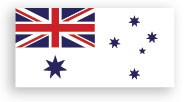
THE AUSTRALIAN WHITE ENSIGN
The Royal Australian Air Force ensign
The Royal Australian Air Force ensign was approved by King George VI in 1948 and formally adopted in Australia in 1949. Previously, the ensign of the British Royal Air Force had been used. The Australian ensign was distinguished from the British ensign by the addition of the Southern Cross and Commonwealth Star. The light blue background symbolises the sky. A leaping red kangaroo was added to the rounded decorative panel (the ‘roundel’) in 1982.
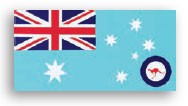
THE ROYAL AUSTRALIAN AIR FORCE ENSIGN
The Australian red ensign
The Shipping Registration Act 1981 confirms the Australian red ensign as the official flag to be flown by Australian-registered merchant ships. Historically, the Australian red ensign was used on land and at sea and Australians have fought under it during the First and Second World Wars.
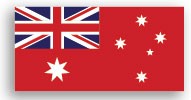
THE AUSTRALIAN RED ENSIGN
Other Australian Government flags
A number of Australian Government flags are flown to represent specific government services, among them the civil air ensign, the Australian Border Force flag and the Australian Federal Police flag.
The civil air ensign
Dating from 1935, the civil air ensign represents the Australian Government organisations responsible for civil aviation. This ensign can be seen flying from civil aviation buildings, boats, aircraft and airports. In 1947, the ensign’s stars were changed from yellow to white, to make it more easily recognised from a distance. These changes were publicly notified in the Commonwealth of Australia Gazette (No 39) of 4 March 1948. The use of the civil air ensign is set out under the Civil Aviation Act 1988.
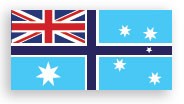
THE CIVIL AIR ENSIGN
The Australian Border Force flag
Ships and aircraft used by the Australian Border Force display the Australian Border Force flag. The flag is the Australian National Flag with the addition of the words ‘Australian Border Force’ in prominent white lettering between the Commonwealth Star and the Southern Cross.
The use and design of the Australian Border Force flag is set out under the Customs Act 1901 and the Customs Regulations 2015.
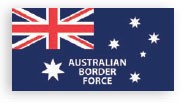
THE AUSTRALIAN BORDER FORCE FLAG
The Australian Federal Police flag
First adopted in 1981, the flag of the Australian Federal Police is flown on buildings of the Australian Federal Police. The flag is predominantly black, with its centre third a white vertical panel on which is placed the badge of the Australian Federal Police, based on the Commonwealth Star, the Crown and the Commonwealth Coat of Arms. The flag has on all four edges a narrow black and white chequer commonly used to represent police services around the world.

THE AUSTRALIAN FEDERAL POLICE FLAG
